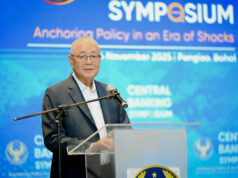BSP: Inflation likely to stay within target range until 2021
INFLATION is likely to settle within the midpoint of the central bank’s target range this year until 2021, with risks tilting slightly upward, according to officials from the Bangko Sentral ng Pilipinas (BSP).
“It’s not something that we should worry about… Inflation will get closer to the midpoint of the target range,” BSP Deputy Governor Francisco G. Dakila, Jr. said during a briefing held at the central bank headquarters in Manila on Friday.
The BSP has set an inflation target range of two to four percent for 2020 until 2021.
BSP Monetary Policy Sub-Sector Officer-In-Charge Dennis D. Lapid cited several upside risks to inflation such as volatility in oil prices caused by tensions in the Middle East and the potential impact of the African Swine Fever on the price of some food commodities.
Petitions for adjustments in electricity rates as well as the higher excise taxes on alcoholic beverages are also flagged as upside risks, Mr. Lapid said in his presentation.
On the other hand, Mr. Lapid said slower economic growth due to the escalation of protectionist policies and geopolitical tensions will be a downside risk to inflation.
Asked how the weather disturbances in countries (like Vietnam and Thailand) where the Philippines mainly imports rice could affect inflation, Mr. Lapid said weather conditions are expected to be “largely neutral” for the most of 2020.
“As of the moment, as I recall correctly, the most recent outlook by the weather services continue to indicate a largely neutral conditions…going into the second and the first half and for most of 2020… So that suggests that we will continue to see, on the whole, normal weather conditions to the agriculture activity,” he said.
Mr. Dakila said the rice tarriffication’s impact to inflation is -0.6%.
Q4 INFLATION
BSP Governor Benjamin E. Diokno said that headline inflation in the fourth quarter of 2019 slowed to 1.6% from 1.7% in the third quarter.
“Inflation slowed down slightly during the quarter due mainly to lower food and non-food inflation,” Mr. Diokno said.
Core inflation also eased to 2.7% in the fourth quarter of 2019, from 2.9% in the preceding quarter.
Inflation in 2019 was at 2.5%, slowing from the 10-year high 5.2% print seen in 2018.
The Monetary Board will have its first policy meeting this year on Feb. 6.
“In terms of decision-making for the policy, the consideration is not whether inflation is going up or down but whether inflation is within the target or not,” Mr. Lapid said.
“A consideration also is the assessment is whether the uptrend is due to temporary supply side or whether we’re seeing a broad-based uptrend in prices,” he added.
Mr. Diokno has previously said that another rate cut is possible as early as the first quarter of 2020, depending on key data and conditions. — Luz Wendy T. Noble



